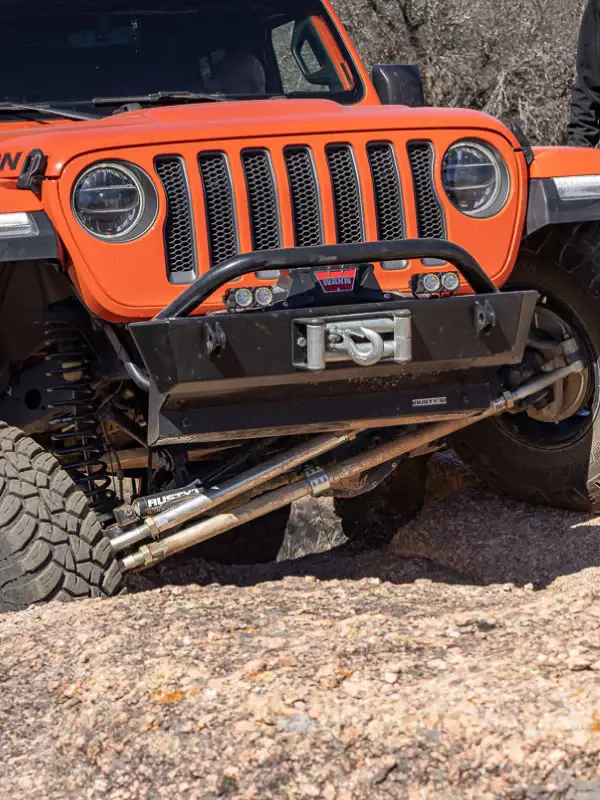Why Gladiator Lift Geometry Works Differently Than Traditional Wrangler Setups
- rustysoffroad
- Aug 13
- 3 min read

The Jeep Gladiator isn’t just a stretched-out Wrangler with a bed slapped on the back. Sure, it looks familiar—but its suspension geometry tells a different story. If you're thinking of throwing a lift on your JT, you need to understand how that geometry works, or you’ll end up with a rig that’s tough to drive and doesn’t flex the way it should.
At Rusty’s Off-Road, we’ve spent decades testing and tuning suspensions across every Jeep platform. So, trust us when we say this—a Jeep Gladiator lift kit requires a completely different approach than a Wrangler lift. Here’s why.
It All Starts with the Frame
The Gladiator’s frame isn’t a simple extension of the Wrangler JL. It’s longer, stiffer, and built with towing and payload in mind. That’s great for hauling gear or towing toys, but it changes how the suspension behaves—especially once you start modifying ride height.
The added length between the front and rear axles (aka the wheelbase) means more leverage is acting on the suspension. That affects your control arms, driveshaft angles, and even steering geometry.
With a Wrangler, the shorter wheelbase means less stress on components when lifted. On a Gladiator, that extra length magnifies every change you make.
Rear Suspension: Not Just Longer—Different
One of the biggest surprises for folks installing a Jeep Gladiator lift kit is how different the rear suspension setup is. While Wranglers use a 5-link design, the Gladiator’s rear suspension is more focused on load-carrying. The control arms are longer, and the rear track bar is mounted in a unique position to handle cargo weight.
That affects how the axle moves when lifted. Without correcting the geometry, you’ll get weird handling and uneven tire wear—especially under throttle or braking. That’s why Rusty’s kits include relocation brackets and tuned-length control arms that restore factory specs after lifting.
Driveshaft Angles and Binding
Lifting a Jeep always affects driveshaft geometry, but the Gladiator’s longer wheelbase makes the problem worse. If you’re using a basic spacer lift or spring-only setup, your driveshaft angles might get pushed too far—leading to vibration, binding, or even premature U-joint failure.
That’s why our Jeep Gladiator lift kits come with tuned shocks, adjustable control arms, and hardware designed to keep everything aligned, smooth, and trail-ready.
Front-End Differences
The front end of the Gladiator shares some components with the JL Wrangler, but the weight distribution is different. The Gladiator’s longer frame and added rear section shift the center of gravity, which changes how weight transfers during cornering and braking.
Add a lift, and you’ll start noticing nose dive, body roll, and wandering steering—unless your geometry is dialed in.
Rusty’s kits fix that with properly engineered track bar brackets, steering stabilizers, and caster correction. You’ll keep that Jeep-truck hybrid feeling planted, stable, and predictable—even on 37s.
Why Rusty’s Gladiator Kits Work
We didn’t just copy a Wrangler lift and stretch it out. Every Jeep Gladiator lift kit we sell is trail-tested on real Gladiators, not just CAD models. Our team has spent hundreds of hours flexing, crawling, towing, and daily driving these trucks to fine-tune each part.
We include relocation brackets to correct axle geometry.
Control arms are made in-house to match the longer wheelbase.
Shock valving is tuned for the Gladiator’s unique weight balance.
Our parts are made right here in the USA and built to last.
If you’re lifting a JT, don’t take shortcuts. Do it right the first time with parts designed for how this truck really works.
FAQs
Q: Can I use my Wrangler JL lift kit on my Gladiator JT?
Not recommended. The frame, suspension angles, and weight balance are different enough to affect performance and safety.
Q: Will a lift affect my towing capability?
Yes, slightly. But with the right components (like bump stops, sway bars, and tuned shocks), the effect is minimal.
Q: Do I need to re-gear my Jeep after lifting it?
If you’re going up in tire size significantly, re-gearing is a smart move for power and MPG—but it’s not required just for the lift.
Final Thoughts
Lifting a Jeep Gladiator is more than just bolting on taller springs. You’re working with a platform that’s part truck, part trail beast. That means understanding how geometry changes and knowing how to correct it.
At Rusty’s Off-Road, we’ve taken the guesswork out of it. Every Jeep Gladiator lift kit we offer is engineered, tested, and tuned for real-world use. Whether you're commuting Monday through Friday or flexing hard on the weekend, we’ve got your back with gear that performs as tough as it looks.
Ready to level up your JT? Check out our jeep xj lift kit built the Rusty’s way—Trail Tested Tough.
Click here to Read More




Comments